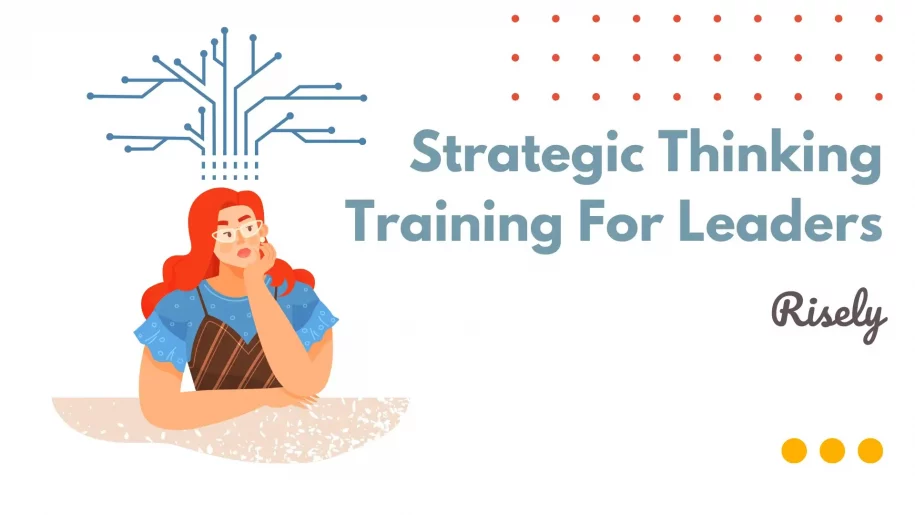Strategic Thinking Training For Leaders Simplified
Strategic thinking is a vital skill for business leaders, managers, and employees in today’s fast-paced, competitive world. It goes beyond day-to-day tasks and involves generating long-term goals, anticipating trends, and making informed decisions to gain a competitive advantage. In this article, we will explore the value of strategic thinking for leadership and discuss various strategic thinking exercises that can help leaders and teams think more strategically.How does strategic thinking training for leaders help?
In a leadership context, a strategic thinker is someone who can think critically, analyze situations, and make decisions that align with the organization’s goals. You need the ability to see the big picture, identify patterns and trends, and develop innovative solutions. Strategic thinking for leaders goes beyond day-to-day tasks and involves a proactive approach to problem-solving and decision-making. Strategic thinking plays a crucial role in achieving organizational goals. By developing a strategic plan, leaders can align their actions with the organization’s overall goals. Strategic thinking helps leaders anticipate potential challenges, identify opportunities, and develop strategies to overcome obstacles. It also ensures that the organization is on the right track toward success. Read more: Top 5 Qualities That Make A Great ManagerCore Components of Strategic Thinking Training
Strategic thinking training focuses on developing key skills essential for strategic thinking. This training includes components such as understanding business strategy, generating new ideas, and enhancing communication skills. By honing these skills, you can approach challenges and opportunities with a strategic mindset, think critically, and effectively communicate your vision to others.Developing a Vision for the Future
Developing a vision for the future is a crucial component of strategic thinking. Leaders need to have a clear vision of where they want their organization to be in the future. This involves considering the big picture, anticipating future trends, and identifying opportunities for growth and innovation. A well-defined vision provides direction and motivation for your team and helps guide strategic decision-making. Read more: What are Leadership Vision Statements? 10+ Examples to Help Build YoursIdentifying and Leveraging Opportunities for Innovation
Identifying and leveraging opportunities for innovation is another important aspect of strategic thinking. Leaders need to stay updated on industry trends and constantly seek new ways to improve their organization. By fostering a culture of innovation, leaders can encourage employees to generate new ideas and explore new opportunities. This not only leads to a competitive advantage but also fuels a sense of drive and competitiveness, helping the organization stay ahead in the market.Strategic Thinking Training Exercises for Managers
Practical exercises are an effective way to build and strengthen strategic thinking skills. These exercises focus on developing a strategic mindset, improving critical thinking, and enhancing problem-solving skills. You can try activities such as:Implementing Scenario Planning for Uncertain Futures
Scenario planning is an exercise that helps leaders envision various future scenarios for their organization. By considering potential risks and challenges, you can develop strategies to mitigate them and prepare for uncertain futures. This exercise involves brainstorming potential situations, analyzing trends, and developing actionable plans. Some key points to consider during scenario planning include:- Identifying potential risks and challenges
- Analyzing the impact of different scenarios on the organization
- Developing strategies to address potential risks and seize opportunities
Engaging in Reverse Brainstorming for Creative Problem-Solving
Reverse brainstorming is a creative problem-solving exercise involving identifying problems instead of solutions. By focusing on potential issues, you can better understand their challenges and develop strategies to prevent or mitigate them. This exercise encourages thinking outside the box and generates new ideas. Some key points to consider during reverse brainstorming include:- Identifying potential problems or obstacles
- Analyzing the root causes of the problems
- Developing proactive solutions to address the problems
Conducting SWOT Analysis to Understand Strengths and Weaknesses
SWOT analysis is a strategic planning tool that helps leaders identify their organization’s strengths, weaknesses, opportunities, and threats. This exercise allows you to evaluate their current situation, understand their competitive advantage, and develop strategies to address potential challenges. Some key points to consider during SWOT analysis include:- Identifying the organization’s strengths and weaknesses
- Analyzing opportunities in the market
- Assessing potential threats and challenges
Applying the Six Thinking Hats for Diverse Perspectives
The Six Thinking Hats technique, developed by Edward de Bono, is a method that encourages leaders to approach problems and decisions from different perspectives. By wearing different “hats,” you can develop a more comprehensive understanding of the situation and make more informed decisions. Some key points to consider when applying the Six Thinking Hats technique include:- Using different modes of thinking, such as facts and information, emotions and feelings, critical judgment, positive aspects, creativity and new ideas, and process and organization
- Encouraging diverse perspectives and critical thinking
- Considering multiple viewpoints before making decisions
Other Interesting Reads
Integrating Strategic Thinking into Daily Leadership Practices
Integrating strategic thinking into daily leadership practices is essential for developing and strengthening strategic thinking skills. Strategic thinking should not be limited to occasional strategic planning sessions but should become a part of a leader’s everyday routine. By incorporating strategic thinking into daily practices, you can develop a habit of seeking strategic insights and considering long-term vision. You can achieve this by setting aside dedicated time for reflection, regularly evaluating the organization’s goals and strategies, and encouraging open discussions about strategic priorities.Daily Habits that Foster Strategic Insights
Developing daily habits that foster strategic insights is crucial for leaders who want to enhance their strategic thinking skills. These habits help you maintain a long-term vision, stay connected to the organization’s goals, and make informed decisions. One effective habit is to allocate dedicated time each day for strategic thinking. You can do this by setting aside a specific time slot to reflect on the organization’s goals, evaluate progress, and identify potential opportunities or challenges. Another habit is to regularly review industry trends, customer needs, and competitive landscapes to stay informed about the external factors that may impact the organization’s strategic direction. Additionally, you can cultivate a habit of seeking diverse perspectives by encouraging open discussions and soliciting feedback from team members. This can provide valuable insights and challenge existing assumptions, leading to more robust strategic thinking.Encouraging a Culture of Strategic Inquiry Among Team Members
Creating a culture of strategic inquiry among team members is essential for fostering strategic thinking within an organization. This culture encourages curiosity, critical thinking, and open communication, which are all crucial for developing strategic insights. You can promote strategic inquiry by creating a safe and inclusive environment where team members feel comfortable asking questions, challenging ideas, and sharing their perspectives. This can be achieved through regular team meetings, brainstorming sessions, and opportunities for cross-functional collaboration. Furthermore, you should encourage effective communication skills among team members. This includes active listening, asking thought-provoking questions, and providing constructive feedback.Navigating the Complexity of Long-Term Planning in Fast-Paced Environments
Long-term planning in fast-paced environments can be challenging due to the complexity and uncertainty involved. Leaders need to navigate these challenges to develop effective long-term strategies. One approach is to break down long-term planning into manageable chunks. This involves setting shorter-term goals and regularly evaluating progress toward the long-term vision. By taking a phased approach, you can adapt strategies based on changing market conditions and emerging opportunities. Leveraging technology and data can also help leaders navigate complexity in long-term planning. Leaders can make informed decisions and anticipate potential outcomes using data analytics and predictive modeling. Additionally, fostering a culture of agility and flexibility within the organization can help leaders adapt their strategies quickly in response to market changes.Strategic thinking training for leaders with Risely
Strategic thinking among leaders can often make or break the deal for teams. But not every leader has the same set of typical challenges to beat! And we get it; that’s why we created hyper-personalized learning journeys that enable skill development in your context. Here is how it works with you and for you:- Step 1: Define your challenges from over 30 options on Risely.
- Step 2: Assess your current position on relevant skills as Risely recommends.
- Step 3: Generate a roadmap of skill development that involves something new every day. We are not going to just talk about strategic thinking—we will build it one step at a time with case studies, sample statements, and more engaging ways.
Conclusion
Strategic thinking is crucial for effective leadership, driving organizational success and innovation. Leaders can navigate uncertainties and propel growth by envisioning the future, seizing opportunities, and embracing diverse perspectives. Strategic thinking can be honed through scenario planning, reverse brainstorming, SWOT analysis, and the Six Thinking Hats technique. Real-world case studies demonstrate how strategic thinking can transform businesses. Integrating strategic thinking into daily practices and fostering a culture of inquiry among team members is key. Start developing your strategic thinking skills today to lead with clarity and agility in an ever-evolving landscape.Assess your strategic thinking skills for free!
Master the art of strategic thinking by reviewing your skills with a free assessment now.
Other Related Blogs
10 Best Strategic Thinking Coaches to Speed Up Your Growth
10 Best Strategic Thinking Coaches to Speed Up Your Growth In the fast-paced and ever-evolving business landscape, strategic thinking has become more than just a desirable trait; it’s a critical…
5 Powerful Skills to Become an Exceptional Business Leadership Coach
5 Powerful Skills to Become an Exceptional Business Leadership Coach In the world of business, leadership is of paramount importance. It is something that makes all the difference. With so…
8 Strategic Thinking Examples to Help You Succeed
8 Strategic Thinking Examples to Help You Succeed Strategic thinking is an essential skill that leaders and managers must possess to steer their teams toward success. It involves analyzing situations,…
Strategic Thinking In Leadership: Secrets To Success From 5 Leaders
Strategic Thinking In Leadership: Secrets To Success From 5 Leaders Leadership is more than just managing people and resources. It’s about having a vision for the future and developing a…


